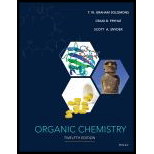
Concept explainers
Interpretation:
The products that would be formed through the indicated sequence of steps from the given starting material are to be identified.
Concept introduction:
Ketones react with meta chloro perbenzoic acid to form esters and the reaction is named as Baeyer Villiger oxidation. If the ketone is cyclic then lactones are formed.
The Grignard reagent or RMgX is a reagent which adds on the alkyl groups to the carbonyl moiety and converts
Swern oxidation is a named reaction which involves the conversion of the primary and secondary alcohol to form aldehydes and ketones.
Alcohols can be converted to ethers by the reaction of an alkyl halide with sodium hydride.
Carboxylic acid gets reduced in the presence of lithium aluminium hydride to form an alcohol.
The reaction of aldehyde/ketone with phosphorus ylide forms
Alkenes undergo reductive ozonolysis on the reaction of ozone with methyl sulfide to form aldehydes or ketones.
Alkenes undergo bromination to form dibromo derivatives.
Friedel Crafts acylation is a substitution reaction which involves the substitution of an acyl group on the benzene ring.
Want to see the full answer?
Check out a sample textbook solution
Chapter 16 Solutions
EBK ORGANIC CHEMISTRY
- a) Give the mechanistic symbols (SN1, SN2, E1, E2) that are most consistent with each of the following statements:arrow_forwardShow how you might synthesize the following compounds, using acetylene and anysuitable alkyl halides as your starting materials. If the compound given cannot besynthesized by this method, explain why.(a) hex-1-ynearrow_forward2. Predict the major product of each of the reactions below and provide a stepwise mechanism which accounts for its formation. Be sure to draw structures for all key intermediates and major products and show electron flow with arrows. All curved arrows must begin from either a bonding pair or lone pair of electrons. Make sure to include stereochemistry and the structure of enantiomer as appropriate. (a) (b) OH OH HBr HBrarrow_forward
- Show how to convert toluene to 3-hydroxybenzoic acid using the same set of reactions as in diagram but changing the order in which two or more of the steps are carried outarrow_forwardWould heating each of the following reactions increase the yield of the product shown? (a) (b) NAOH Br Nao CIarrow_forwardc) Compound A below undergoes Dieckmann cyclization to give compound B in the presence of a base. Dieckmann EtO OEt cyclisation OEt Base CH3 A i) Give the appropriate base for the above reaction and draw the resonance structures of the enolate ions derived from compound A. ii) If compound B above is reacted with NaBH4, draw the structure of the reduced product. Explain a reason for your choice of the product.arrow_forward
- Kindly answer question a, b & carrow_forward(a) 1-methylcyclopentene B can be prepared by an intramolecular Wittig reaction from A. Propose a plausible arrow-pushing mechansim for this the transformation from A to B. (b) Propose a synthesis to convert 1-methylcyclopentene B to the cyclic ester C. Show all intermediates, and reagents necessary for each step.arrow_forward(b) Give reagents and conditions that will allow ALL of the following synthetic transformations to be achieved. More than one synthetic step may be required in each case. You may assume that any required additional reagents will be available. HO OH e (1) (ii) 6 (iii) -6 O-SiMe3 O₂N- O₂N OH (c) Give reagents and conditions that will allow the following synthetic transformation to be achieved using organosilicon chemistry. More than one synthetic step will be required. Ph-H CH₂CH3 Ph Aarrow_forward
- Which of the following compounds will undergo an SN2 reaction more easily? (a) neopentyl iodide (b) tert-butyl chloride (c) 2-iodopropane (d) 4-methyl-1-iodopentane (e) 1-chloro-4-methylpentane. Briefly justify your answer. Which of the mentioned compounds will undergo an SN1 reaction more easily? Briefly justify your answer.arrow_forwardSuggest a reasonable series of reagents and reactions conditions to prepare cis-2-methylcyclohexly acetate (A) from trans-2-methylcyclohexanol.arrow_forwardA key step in the synthesis of naproxen, an NSAID more commonly known by its brand name, Aleve (Section 3.9), is a coupling reaction of 2-bromo6-methoxynaphthalene to form 2-methoxy-6-vinylnaphthalene. Show three different coupling reactions, and the required reagents, that could be used to carry out this step.arrow_forward

 Organic ChemistryChemistryISBN:9781305580350Author:William H. Brown, Brent L. Iverson, Eric Anslyn, Christopher S. FootePublisher:Cengage Learning
Organic ChemistryChemistryISBN:9781305580350Author:William H. Brown, Brent L. Iverson, Eric Anslyn, Christopher S. FootePublisher:Cengage Learning

